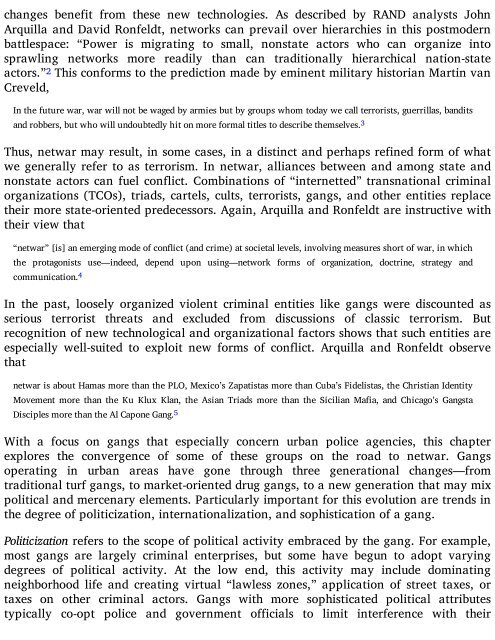RAND_MR1382
You also want an ePaper? Increase the reach of your titles
YUMPU automatically turns print PDFs into web optimized ePapers that Google loves.
changes benefit from these new technologies. As described by <strong>RAND</strong> analysts John<br />
Arquilla and David Ronfeldt, networks can prevail over hierarchies in this postmodern<br />
battlespace: “Power is migrating to small, nonstate actors who can organize into<br />
sprawling networks more readily than can traditionally hierarchical nation-state<br />
actors.” 2 This conforms to the prediction made by eminent military historian Martin van<br />
Creveld,<br />
In the future war, war will not be waged by armies but by groups whom today we call terrorists, guerrillas, bandits<br />
and robbers, but who will undoubtedly hit on more formal titles to describe themselves. 3<br />
Thus, netwar may result, in some cases, in a distinct and perhaps refined form of what<br />
we generally refer to as terrorism. In netwar, alliances between and among state and<br />
nonstate actors can fuel conflict. Combinations of “internetted” transnational criminal<br />
organizations (TCOs), triads, cartels, cults, terrorists, gangs, and other entities replace<br />
their more state-oriented predecessors. Again, Arquilla and Ronfeldt are instructive with<br />
their view that<br />
“netwar” [is] an emerging mode of conflict (and crime) at societal levels, involving measures short of war, in which<br />
the protagonists use—indeed, depend upon using—network forms of organization, doctrine, strategy and<br />
communication. 4<br />
In the past, loosely organized violent criminal entities like gangs were discounted as<br />
serious terrorist threats and excluded from discussions of classic terrorism. But<br />
recognition of new technological and organizational factors shows that such entities are<br />
especially well-suited to exploit new forms of conflict. Arquilla and Ronfeldt observe<br />
that<br />
netwar is about Hamas more than the PLO, Mexico’s Zapatistas more than Cuba’s Fidelistas, the Christian Identity<br />
Movement more than the Ku Klux Klan, the Asian Triads more than the Sicilian Mafia, and Chicago’s Gangsta<br />
Disciples more than the Al Capone Gang. 5<br />
With a focus on gangs that especially concern urban police agencies, this chapter<br />
explores the convergence of some of these groups on the road to netwar. Gangs<br />
operating in urban areas have gone through three generational changes—from<br />
traditional turf gangs, to market-oriented drug gangs, to a new generation that may mix<br />
political and mercenary elements. Particularly important for this evolution are trends in<br />
the degree of politicization, internationalization, and sophistication of a gang.<br />
Politicization refers to the scope of political activity embraced by the gang. For example,<br />
most gangs are largely criminal enterprises, but some have begun to adopt varying<br />
degrees of political activity. At the low end, this activity may include dominating<br />
neighborhood life and creating virtual “lawless zones,” application of street taxes, or<br />
taxes on other criminal actors. Gangs with more sophisticated political attributes<br />
typically co-opt police and government officials to limit interference with their










![Genki - An Integrated Course in Elementary Japanese II [Second Edition] (2011), WITH PDF BOOKMARKS!](https://img.yumpu.com/58322134/1/180x260/genki-an-integrated-course-in-elementary-japanese-ii-second-edition-2011-with-pdf-bookmarks.jpg?quality=85)
![Genki - An Integrated Course in Elementary Japanese I [Second Edition] (2011), WITH PDF BOOKMARKS!](https://img.yumpu.com/58322120/1/182x260/genki-an-integrated-course-in-elementary-japanese-i-second-edition-2011-with-pdf-bookmarks.jpg?quality=85)





